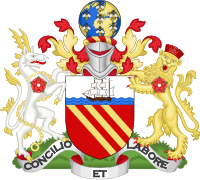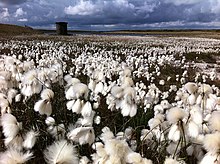Symbols of Manchester
| Symbols of Manchester | |
|---|---|
 The coat of arms of Manchester City Council since 1842 |
The City of Manchester in North-West England has traditionally been represented by various symbols. Most of these symbols are derived from heraldic emblems contained within the city's official heraldic achievement, which was officially adopted when the Borough of Manchester was granted city status in 1842. Notably, the motif of the worker bee has been widely used to represent the city as a symbol of industry.[1]
Heraldry[]

The heraldic achievement of Manchester (colloquially but inaccurately referred to as a coat of arms) were granted to the Borough of Manchester in 1842 and continue to be used today by Manchester City Council.[2]
Arms: Gules three Bendlets enhanced Or a Chief Argent thereon on Waves of the Sea a Ship under sail proper.
Crest: On a Wreath of the Colours a Terrestrial Globe semée of Bees volant all proper.
Supporters: On the dexter side a Heraldic White Hart Argent attired collared and chain reflexed over the back Or and on the sinister side a Lion guardant Or murally crowned Gules each charged on the shoulder with a rose of the last.
Motto: Concilio et Labore ("By Counsel and Work")
At the centre of the arms is a heater-style escutcheon, or shield, with gold stripes on a red field representing the rivers Irwell, Medlock and Irk, which flow through Manchester. The chief symbol at the top of the shield is a ship in full sail, representing the city's trade with the rest of the world. On either side of the shield are a pair of supporters, an antelope and a lion, each bearing the Red Rose of Lancaster on its shoulder, derived from the arms of King Henry IV, Duke of Lancaster. The lion is said to symbolise bravery and strength, while the antelope stands for peace, harmony, courage and discipline. At the top, the crest consists of seven bees flying over a globe, symbolising Manchester's industry being exported across the world. At the foot of the arms is the city's Latin motto, Concilio Et Labore, which is loosely translated to "by wisdom and effort" or "by counsel and work", a phrase taken from the Book of Ecclesiasticus 37:16: "Let reason go before every enterprise, and counsel before every action".[3][4]
The heraldic arms appears on many architectural features around Manchester, including Manchester Town Hall and the Corn Exchange, and on blue plaque in the city.[4]
Worker bee[]

The worker bee is one of the best-known symbols of Manchester. It was adopted as a motif for Manchester during the Industrial Revolution, at a time when Manchester was taking a leading role in new forms of mass production, and symbolises Mancunians' hard work during this era and Manchester being a hive of activity in the 19th century.[5][6]
HMS Manchester was nicknamed Busy Bee after the Manchester bee symbol, and the bee is depicted on the ship's crest, which is also present on the ship's funnel.[7] In the early 1970s the famous Boddingtons logo was introduced, depicting a barrel and two bees.[8] The University of Manchester's coat of arms features three bees. The bees are depicted on many structures in Manchester such as lampposts and bollards.[9] The 2009/10 away kit of Manchester City was inspired by the Manchester bee, featuring a black shirt with yellow shoulder inserts.[10][11]
Following the May 2017 Manchester Arena bombing, the bee emblem gained popularity as a public symbol of unity against terrorism, appearing on protest banners and graffiti. Tattoo parlours both in and outside Manchester began to take part in the Manchester Tattoo Appeal, in which they offered bee tattoos to raise money for the victims of the attack.[12][13]
Floral emblems[]

Lancashire rose[]
Manchester is part of the historic county of Lancashire, within the Salford Hundred. This is reflected in the use of the Red Rose of Lancaster in Manchester's heraldic arms. After the reform of local government in 1974, Manchester was removed from Lancashire for ceremonial and administrative purposes and brought into the new metropolitan county of Greater Manchester. After the change, both the City of Manchester and the new county retained the Lancastrian Rose in many emblems.
Cottongrass[]

Eriophorum angustifolium, commonly known as Cottongrass, is the county flower of Manchester.[14] Cottongrass was selected because of Manchester's association with cotton, chiefly during the 19th century, when the city was given the nickname of Cottonopolis.
Three rivers[]
On the Manchester City Council arms, the three golden diagonal stripes on the red shield are meant to symbolise the three rivers which run through Manchester city centre: the Irwell, the Irk and the Medlock. This heraldic device has been adopted in other popular symbols, such as in the logo of Manchester United F.C. until the early 1970s and Manchester City Football Club (between 1972 and 1997, the club replaced the stripes with the Red Rose of Lancashire, but the logo now combines the stripes and the flower).[15]
References[]
- ^ "The rise of the 'greatest village in England'". Manchester Evening News. menmedia.co.uk. 2012-11-03. Retrieved 2012-11-09.
- ^ Frangopulo, N. J., ed. (1962) Rich Inheritance. Manchester: Education Committee; p. II (note by W. H. Shercliff)
- ^ "The antelope, the lion and the bees". BBC News. Archived from the original on 29 May 2017. Retrieved 29 May 2017.
- ^ a b "Up In Arms: Manchester's Badge On Buildings". Manchester Confidential. Retrieved 29 May 2017.
- ^ "Why the worker bee is a symbol of Manchester". inews.co.uk. 24 May 2017. Retrieved 2017-05-25.
- ^ "'Peaceful but not to be messed with' – how the bee came to symbolise Manchester". The Guardian. 24 May 2017. Retrieved 2017-05-25.
- ^ "HMS Manchester sets sail". Manchester Evening News. 30 January 2009. Retrieved 11 July 2011.
Her funnel crest includes a bee which is taken from the city's coat of arms, signifying industry and endeavour.
- ^ "Manchester - Entertainment - Boddies: 200 years of beers". BBC. Retrieved 2011-08-11.
- ^ "Manchester history: the bees, the bees!". Creative Tourist. 22 February 2013. Retrieved 2014-04-04.
- ^ "Gallagher hails City's new strips". Four Four Two. 5 June 2009. Retrieved 2018-05-23.
The away kit is a nod to Manchester’s symbol of industry and coat of arms – the Apis Millifera – more commonly known as ‘the bee’. The shirt is black with yellow and gold inserts on the shoulders used to define and accentuate the upper torso.
- ^ "MCFC Away Kit available to pre-order". 30 July 2009. Archived from the original on 2 March 2012. Retrieved 2018-05-23.
The away kit is a nod to Manchester’s symbol of industry and coat of arms – the Apis Millifera – more commonly known as ‘the bee’. The shirt is black with yellow and gold inserts on the shoulders used to define and accentuate the upper torso.
CS1 maint: bot: original URL status unknown (link) - ^ "Manchester attack: Hundreds queue for bee tattoos". 26 May 2017 – via www.bbc.com.
- ^ "Hundreds line up to get 'worker bee' tattoos to raise money for Manchester attack victims". businessinsider.com.
- ^ "Cotton-grass (Common)". Plant Life. Retrieved 2014-04-04.
- ^ "Manchester City History". MCIVTA. Archived from the original on 30 May 2017. Retrieved 30 May 2017.
External links[]
| Wikimedia Commons has media related to Symbols of Manchester. |
- Cooper, Matthew (26 May 2017). "Why is a bee the symbol of Manchester?". Manchester Evening News. Trinity Mirror. Retrieved 29 May 2017.
- Manchester
- Municipal coats of arms in Greater Manchester
- Coats of arms of metropolitan district councils of England
- Coats of arms with bends
- Coats of arms with ships
